|
NEWS NOTES
Chemicals melt out of glaciers
 Courtesy of Heidi Geisz |
| Researchers studying Adélie penguins in Antarctica found that DDT is melting out of the ice and entering the ecosystem. |
Sparkling majestically in the blazing sunlight, Antarctica’s massive glaciers appear as pristine as one would expect in a place that lies far away from other landmasses and where no humans have ever lived. But new research suggests that these frosty vaults contain contaminants such as DDT that traveled thousands of kilometers through the atmosphere before condensing and raining down at the poles. And as the glaciers melt, pollutants trapped inside them are being released into the water — and into the Antarctic food chain.
Heidi Geisz of the Virginia Institute of Marine Science in Gloucester Point, Va., uncovered this unlikely source of pollution while testing Adélie penguin carcasses and eggs in the Antarctic Peninsula for DDT. The insecticide is one of the only chemicals for which detailed long-term usage data are available, making it an ideal candidate for following its cycle through the environment, Geisz says. DDT was banned in the Northern Hemisphere and regulated worldwide in the 1970s, but some places in the Southern Hemisphere still use the insecticide. But because Adélie penguins don’t venture beyond the Antarctic Polar Front that encircles the Antarctic continent, they do not come in direct contact with such point sources of the chemical. “That makes them good study subjects for looking at global background levels of these chemicals,” she says.
Geisz and her colleagues expected concentrations of the chemical to have decreased in the birds, as they have in many Arctic animals over the past decade. But when the team compared current levels to DDT levels measured in other ecosystems throughout the past 30 years by other researchers, they found that DDT concentrations have stayed the same. The results suggest that Antarctica harbors a source that feeds the chemical into the Antarctic marine food web. That source is most likely glacial meltwater, Geisz and colleagues wrote June 1 in Environmental Science & Technology.
The study shows an example of some of the unexpected effects of climate change, says David Schindler, an ecologist at the University of Alberta in Edmonton, Canada. “Thirty years ago we probably thought that these stores of pesticides would be sealed in these huge ice caps for all time but now they are melting out.”
Geisz says that DDT is trapped in Arctic glaciers as well and that local animals likely take it in through meltwater there too. However, concentrations of the chemical in Arctic animals are generally higher than in the Antarctic penguins because DDT was mainly used in the Northern Hemisphere. Because the Arctic animals had more direct contact with the chemical, the small impact of DDT-laden meltwater would be harder to observe, she says, which might explain the difference between Antarctic and Arctic trends.
The DDT concentrations in Adélie penguins are low enough that the pollutant is probably not harming them, Geisz says. And once the layer of ice that built up during and after the widespread use of DDT melts away, the source will have vanished along with it. But DDT is not the only chemical trapped in ice. “Of more concern are some of the similar contemporary chemicals that we now know are flying off to those same latitudes and which are still widely used,” such as the pesticide hexachlorocyclohexane, Schindler says. And then there are those pollutants that were bouncing around in the atmosphere in the past, such as lead from the Romans and — more recently — mercury, says Paul Schuster, a hydrologist with the U.S. Geological Survey in Boulder, Colo. All of these compounds are trapped in glaciers worldwide — not just at the poles — and climbing temperatures will eventually set them free.
Previous studies by Schindler and his colleagues found organic pollutants such as insecticides melting out of alpine glaciers in the Rocky Mountains. And studies in Europe have found polychlorinated biphenyls, or PCBs, Schindler says. With alpine glaciers melting faster than those in Antarctica, Schuster says, that could have consequences not only for animal life but also for humans living in the Andes, the Himalayas and elsewhere, who rely on alpine glaciers for their drinking water.

 Subscribe
Subscribe


